#congregation brith shalom
Text
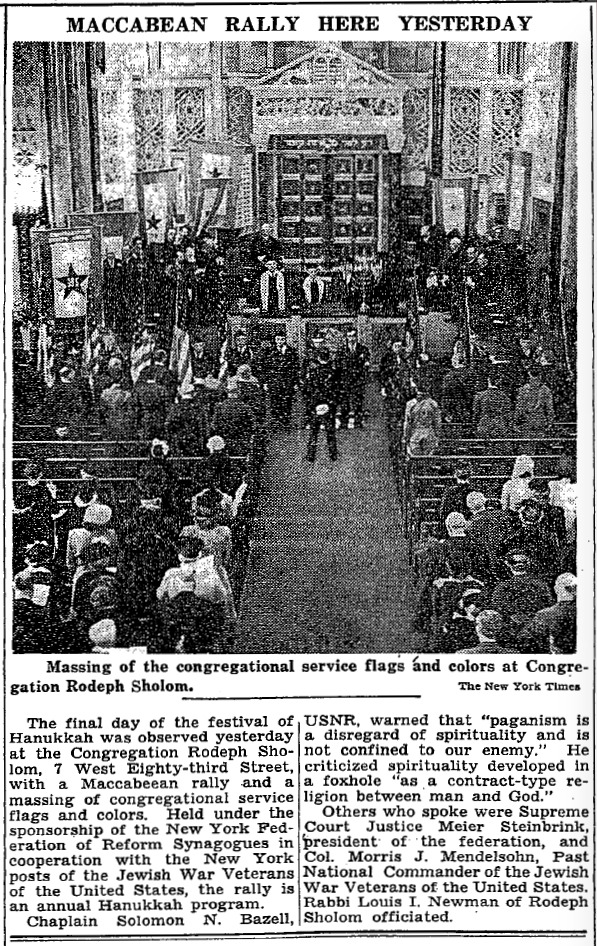
Hanukkah, 1944: Civil religion in New York City, London, and Nottingham
Above, from The New York Times, December 18th, 1944.
Lt. s.g. Bazell (1901-1963), a Reform rabbi, was born in Russia and was brought to the United States as an infant. He graduated from the University of Cincinnati, and received his ordination in 1923 (they were ordained really young in those days) from Hebrew Union College. Prior to induction in 1943 he served Temple Brith Sholom in Louisville, Kentucky. I've been unable to trace his post-war career; he seems to have been still in the Navy in late 1945. His son Haskell Bazell, a lawyer, was our neighbor in Berkeley, California, when I was an infant, and remained a good friend after we moved to Chicago. We lost touch at some point.
When I first moved to New York City in 1996 I lived just a few minutes' walk from Congregation Rodeph Shalom, and visited while "synagogue shopping." Even at a higher resolution, this photograph would hardly begin to do justice to the beauty of that sanctuary, and the music was excellent at the time. I found the overall atmosphere a bit chilly, however, and kept looking.
Meanwhile, in London, both the West London Chronicle on December 8th (above) and the Middlesex Independent and West London Star on December 9th carried notices for what was no doubt an interesting service...
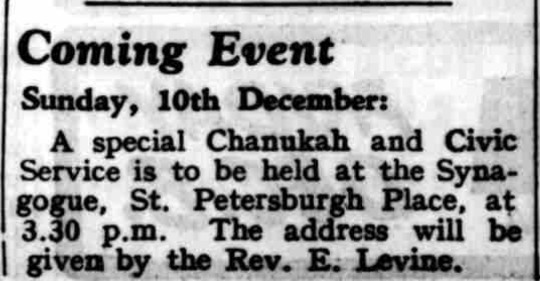

...but I haven't been able to find any coverage of the event itself.
That wasn't the case in Nottingham, where the Nottingham Journal both announced a local service on December 9th...

...and reported on it (and what followed) on December 11th:
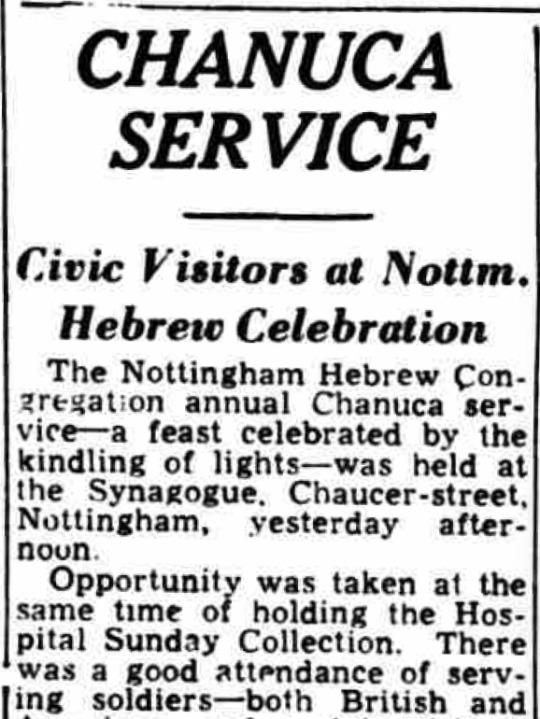
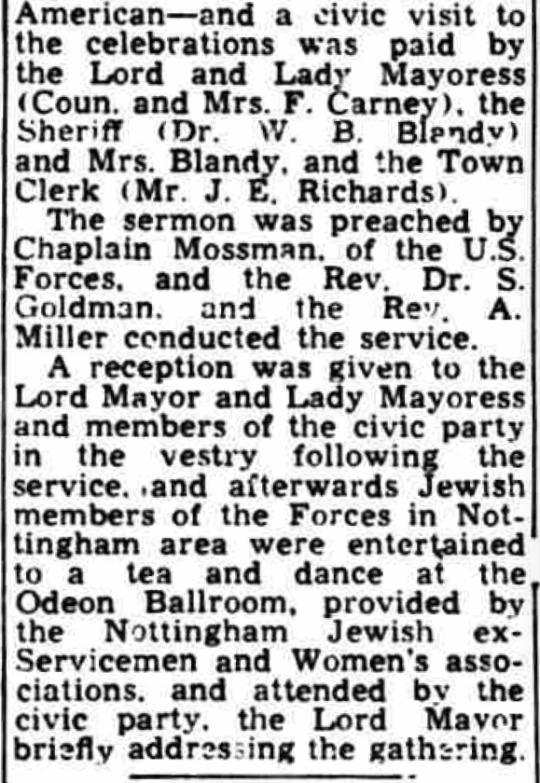
Captain Sidney K. Mossman, an Orthodox rabbi, was born in Canada in 1913 and came to the United States in 1930. In 1936 he graduated from DePaul University, here in Chicago, with a Bachelor of Laws degree (a credential that no longer exists); just two years later he received ordination from Hebrew Theological College, then in Chicago and how in Skokie. Prior to joining up in 1943 he served Congregation Knesseth Israel in Hammond, Indiana. He was still in the Army in late 1945; once again, I've been unable to trace his post-war movements.
(All images except the first are ©The British Library Board. All Rights Reserved.)
2 notes
·
View notes
Text
New Collections, 2019-05-07
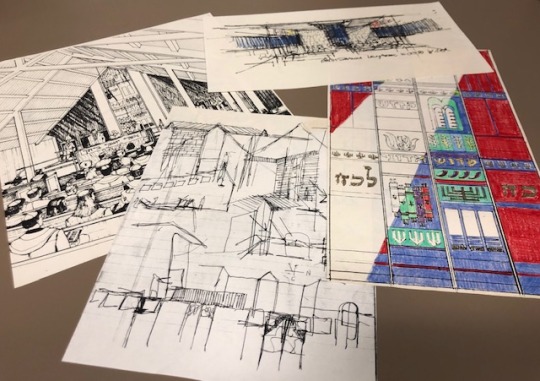
Morton and Jean Levy papers, MS 845
The collection consists of one box containing a scrapbook of, primarily, Morton Levy's architectural drawings of the proposed renovation to Congregation Brith Shalom's interior, correspondence, news clippings, and photographs of the congregation's interior from 1986-1996. In addition to the drawings in the scrapbook there are ten prints from Levy's portfolio (1997) of a number of synagogues that he worked on. The rest of the material -- two Congregation Beth Israel bulletins, news clippings, and two group photographs of Barnston B.B.G. members -- is from 1948 to 1954.
Morton Levy, a native Houstonian, graduated from high school in 1951. He received his Bachelor of Arts degree from Rice Institute in 1955 and his Bachelor of Science in Architecture, with distinction, from Rice in 1956. He founded his own architectural practice in 1963 and was licensed to practice architecture in Texas from 1960 through 2014. The resume for his award-winning practice includes service as architectural consultant to the U.S. Postal Service for thirteen years, eighteen projects for the City of Houston Department of Health and Human Services, four projects for the Houston Independent School District, seven Houston area synagogues, and eight renovation/expansion projects for the Houston Jewish Community Center. He retired in 2015.
Jean Merle Kanowitz Levy is a native of Pittsburgh, Pennsylvania, but moved with her family to Houston at the age of nine. A graduate of San Jacinto High School in Houston, Jean went on to receive a degree in Liberal Arts Studies from the University of Houston. Morton and Jean married in 1960 and have three children: Nanette (1961), Jay (1965), and Lisa (1966).

Shearith Israel Congregation collection, MS 738
The collection contains six boxes of correspondence, event materials (including programs, correspondence, and memorabilia), newsletters, bulletins, news clippings, books, photographs, financial documents, sermons, and video and audio material of events that document the history of Shearith Israel Congregation in Wharton, Texas, from 1921 to 2002.
Shearith Israel Congregation had its inception in 1899 when the Jewish citizens of Wharton, Texas, first met to conduct religious services, using members' homes as meeting places. As the community grew and the number of Jewish families increased plans were formulated for the building of a Synagogue. At first the membership consisted mainly of Wharton citizens, but as the Jewish population increased in surrounding towns the congregation expanded to include those who lived nearby from El Campo, Bay City, Ganado, Edna, Palacios, and Richmond. A tract of 2.14 acres was purchased and the building was completed in the fall of 1940. In 1956, the community dedicated a new, state-of-the-art synagogue building in the shape of a six-pointed Star of David at 1821 Old Lane City Rd., designed by Houston Jewish architect, Lenard Gabert. Perhaps, the most notable and enduring feature of the property, however, was the barbecue pit. Shearith Israel’s annual barbecue fundraiser, the social event of the year for the community, attracted hundreds of Jews and non-Jews from the area, as well as relatives and former members, who descended upon Wharton to eat chicken and cole slaw. The synagogue closed its doors in 2002, when membership dwindled from a peak of 400 members down to just 39, and sold its facilities. In 2010, the main building burned to the ground, and, besides the community hall that still stands, visitors to the site today will see nothing but a concrete slab where the sanctuary and school once stood.
Herman and Margarett Root Brown Family papers, MS 697
The collection consists of a range of keepsakes memorializing the lives of Herman and Margaret Root Brown and their family. The oldest in time are the high school senior class yearbook of Herman Brown and a framed loan document bearing his signature. There are many photographs, both formal portraits and small snapshots as well as intermediate size pictures. Among the people featured in addition to Herman, Margaret, and their children are the mother and sisters of Herman and George Brown, the wife and daughters of George, and some business associates.
Herman Brown, born in Belton, Texas in 1892, and Margaret Root, born in 1895, were married in 1917. Having begun doing construction work in Belton in 1914 and being paid in used equipment and mules, Herman formed a business which his brother-in-law Dan Root joined in 1919. They were in turn joined by Herman’s younger brother George in 1922. For the first twenty years their work was primarily road paving and bridge building throughout Texas. In 1942, with federal government involvement through freshman congressman Lyndon Baines Johnson, they completed a 1.3-mile-long dam near Austin.
World War II prompted the company’s expansion into ship-building, and it produced 359 destroyer escorts and other ship types. After the war Brown and Root expanded by acquiring (for $143 million) the U.S. government’s Big Inch and Little Big Inch pipelines (originally built to replace tanker ships vulnerable to German submarines).
In 1951 Herman and George Brown and their wives set up the Brown Foundation, which has made large gifts beginning with Rice University, Southwestern University (Margaret Root Brown’s alma mater), and the Museum of Fine Arts, Houston.
Two children joined the family of Herman and Margaret Brown, who had no children of their own. Louisa and Michael Stude were adopted and raised by the Browns but kept their birth names because their natural parents were still living.
Herman Brown died on November 15, 1962, and Margaret followed in 1963. To honor the memory of Margaret, George Brown and his wife Alice donated funds used to establish a residential college at Rice University. Margaret Root Brown College was dedicated October 3, 1965.
#congregation brith shalom#houston jewish history#houston jewish history archive#jean levy#lenard gabert#morton levy#shearith israel congregation#wharton#herman brown#margaret root brown#george brown#lyndon baines johnson#lbj#brown and root#special collections#rice university
3 notes
·
View notes
Photo
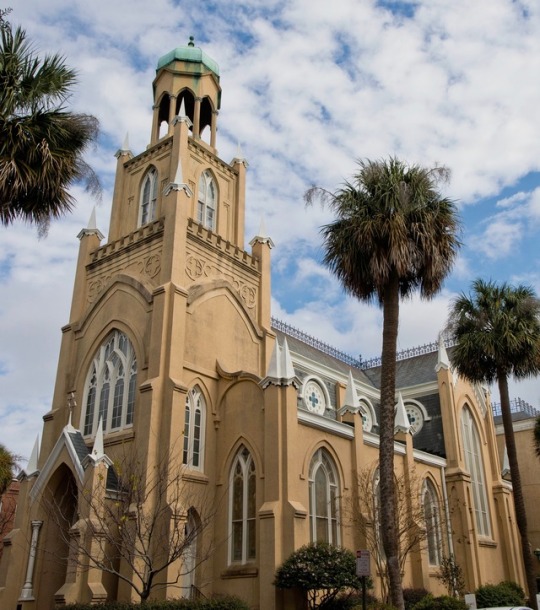


SAVANNAH SHOWCASES ITS COLONIAL JEWISH HERITAGE
By Harry D. Wall
A visit to Savannah and its nearly 300 year-old congregation, Mickve Israel. A supersize building, the last neo-Gothic synagogue in America, it’s museum contains deerskin torahs brought over by the first settlers in 1833 and letters from the Founding Fathers. Photos by Richard Nowitz
As first-time visitors to Savannah’s Mickve Israel synagogue in Georgia, we circled around Montgomery Square and what we thought was a church or cathedral, a huge building with pointed arches, barrel vaults, and a soaring cupola. But as we soon discovered, this was the Mickve Israel, a landmark listed as the only standing neo-Gothic synagogue in America.
Once inside, the sanctuary is no less impressive. One of the oldest congregations in the US – founded in 1733, the current building opened in 1878 – it is a bold, ecumenical architectural statement, with flying buttresses and tall stained glass windows. The building reflects the comfort and assimilation of this southern Jewish community, affiliated with the Reform movement.
Inside this supersized synagogue is an exquisite museum, documenting the heritage of the 280-year-old congregation from its colonial roots. Forty-two financially strapped, mostly Sephardic Jews from London braved a rough ocean crossing on the William and Sarah, arriving in Savannah in July 11, 1733, just five months after the colony of Georgia was established.
They were welcomed by Georgia’s founder, James Oglethorpe. Taking a tour with Rabbi Robert Haas, a former Texan who has been spiritual leader of Mickve Israel for five years, we discover fascinating artifacts of the congregation’s history. There are the two oldest torah scrolls in the U.S., brought over from England in the early 18th century. Made of deerskin (yes, it’s kosher if slaughtered properly), they are over 500 years old, originating from Spain or Portugal.
There are also glass-encased letters from George Washington, Thomas Jefferson and James Madison, among other presidents. The letters reflect the prominence and acceptance of this southern Jewish community, a variance of what many northerners think about prejudice and anti-Semitism and the South.
“Jews have enjoyed respect and full acceptance here throughout the community’s history,” said Rabbi Haas. “We have strong ties to the city and other faiths, and very little in anti-Semitic incidents.”
The history of Jews in Savannah, along with other parts of the South, is also conflated with slavery. As landowners and merchants, Jews did own slaves, although there is no documentation of that in the museum.
“Jews have played an important role in Savannah, going back to the Revolutionary War,” Rabbi Haas said. The museum exhibition features Uriah Phillips Levy, who was a commodore in the colonial navy, knownd for cessation of flogging. (He also funded Thomas Jefferson’s estate, Monticello). There have been Jewish mayors, writers, leading physicians and scientists, one of the most notable, Raphael Moses, who developed the technology for shipping peaches long distances, giving some credit to him as a father of “the peach state”. The Girl Scouts of America was
founded in Savannah with the support of Jewish women. The museum also highlights the prominence
The museum also highlights the prominence of its Ashkenazi congregants, German Jews going back to Benjamin Sheftall, who arrived with the original group from England in 1733 and whose heirs were major benefactors of the community. In fact, said Rabbi Haas, there are descendants of Sheftall who are active members of the congregation today. A drive from Mickve Israel to the commercial center passes through the historic downtown district, punctuated by green public squares, antebellum mansions and charming townhouses. Not much remains of the many Jewish stores that thrived on Broughton and Bull streets, though there are signs marking the buildings of Adler’s department store, Joseph’s clothiers, and Maxwell’s.
Nearby, on Montgomery Street, is a tall Moorish building with arabesque façade and keyhole windows, once the home of the Bnai Brith Jacob Synagogue, now part of the Savannah College of Art and Design. The Orthodox congregation has since moved out of the downtown district.
The Bonaventure Cemetery’s Jewish section, with its distinctly Southern wrought iron gates and decorative gravestones, also captures the community’s history. On Bull Street, a sign commemorates the cemetery of the original Jewish setters.
There are about 3,500 Jews living in Savannah today, said Rabbi Haas, and three synagogues, enjoying close cooperation. There are Jewish festivals, including the very popular “Shalom Y’all Jewish Food Festival,” which draws thousands of people to get a taste of Jewish food and culture.
3 notes
·
View notes
Text
D'var Torah: B'shallach 5779 / 2019
D’var Torah: B’shallach 5779 / 2019
Offered at Temple B’nai Brith – Kingston, PA, USA
Shabbat shalom! Thanks for welcoming me to your congregation on this erev Shabbat. And for giving me the chance to share a few thoughts on this week’s Torah portion, B’shallakh, from the book of Exodus. We are right in the middle of what might be the biggest drama of the entire Torah narrative. The 10 plagues have devastated ancient Egypt, and…
View On WordPress
0 notes